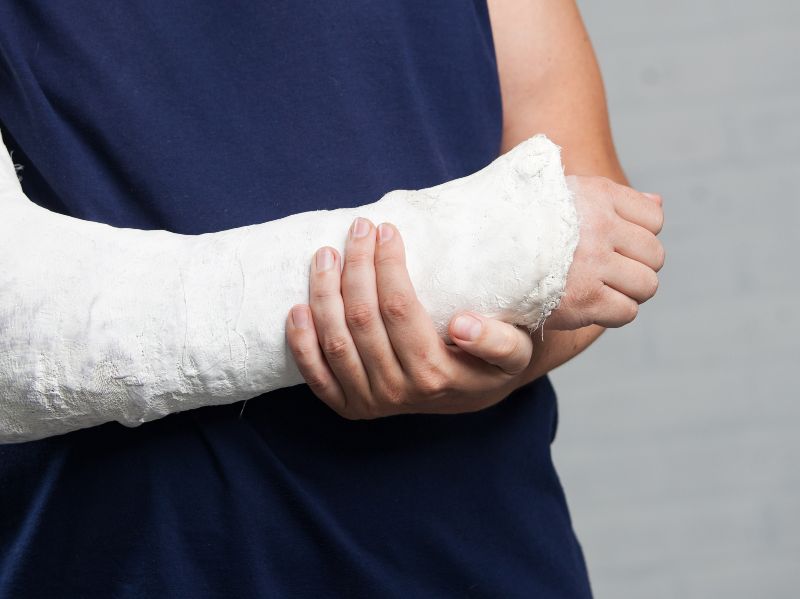
Most important part of your body when it comes to playing volleyball are your beloved arms. Name any volleyball movement; it won’t be possible unless you use your arms …
This obviously increases the risks of arm injuries which is not an uncommon thing in volleyball.
However, many amateurs and newbies are wondering and being worried whether this could extend to the point where this could literally break their arms.
In this article I address this big concern and try to help with some solutions to prevent hurting your arms in any way possible.
Let’s dive in!
Most common volleyball arm injuries …
1. Shoulder injuries
Young players may develop shoulder instability as a result of volleyball’s repetitive overhead serving, spiking, and blocking movements.
The muscles and ligaments may get stressed as a result of the arm’s extreme postures during these movements.
Overusing the rotator cuff is the most frequent cause of shoulder pain in volleyball players, which makes sense given that the average volleyball hitter or server hits the ball thousands of times throughout a regular season.
Numerous additional conditions, including ripping off the inferior glenohumeral ligament or the labrum, can also cause shoulder pain.
Players that frequently use their shoulders in excessive external rotation, such as servers and hitters, may develop glenohumeral internal rotation deficit, which limits the shoulder’s ability to rotate internally in comparison to the side that is not their dominant one.
With instability, rest and physical therapy can help. The goal of therapy is to strengthen the muscles that surround the shoulder, notably the rotator cuff muscles. Surgery might be necessary in severe cases of instability (repeated shoulder dislocations).
A great way to help correct or prevent that is by using shoulder tapes (Check these quality should tapes Here at Amazon)
2. Finger injuries
Any sport that involves handling a ball frequently results in finger trauma, and volleyball is no exception.
Activities like blocking, setting, and digging in volleyball put fingers at risk for harm.
Fractures, dislocations, and tears in ligaments and tendons are all frequent finger injuries.
Axial loads to the fingertip and hyperextension of the finger from the ball can seriously hurt blockers. If a hitter strikes the net or another player during the follow-through phase of the swing, they risk suffering finger injuries.
For the majority of finger injuries, radiographs are required to rule out fracture or dislocation. The proximal interphalangeal joints of the fingers are the site of ligamentous injury in the majority of finger injuries.
The severity of a finger injury will determine the appropriate form of treatment. With rest, ice, and buddy tape, most sprains heal well. Surgery or a cast may be required for more serious injuries.
A great way to help protect your beloved fingers is by using finger tapes (Check these quality should tapes Here at Amazon)
3. Wrist injuries
The wrist consists of several tiny bones that are held together by ligaments and tendons. The tendons and ligaments in the wrist may get damaged from overuse or overload.
Damage to the wrist’s ligaments, the powerful bands of fibrous tissue that attach bones to one another inside a joint, results in a sprain.
The wrist has numerous joints that connect 15 different bones, although most people refer to it as a single joint that connects the forearm to the hand.
Any excessive twist, bend, or impact that abruptly forces the wrist into a position outside of its normal range of motion has the potential to rip the ligaments connecting these bones.
Ice, nonsteroidal anti-inflammatory medicines, and refraining from further ball impact at the area are the primary treatments. While not playing, wearing a thumb splint may also be beneficial.
Tools to help protect your arms while playing
1. Arm sleeves
They are typically made of elastic material that softly encircles arms. I would suggest the traditional compression arm sleeves, which also cover your elbow and the majority of your biceps (Check this example Here at Amazon)
You may occasionally see arm sleeves that merely cover your forearms. The support of the muscles and increase of blood circulation is perhaps the most crucial functions of arm sleeves, and using compression sleeves might give you an advantage over other players.
Arm sleeves gently press against the skin’s outer layer. This causes a slight rise in blood pressure in the arms, which facilitates an overall increase in blood flow throughout the body. As the heart rate rises, the blood flow likewise grows with time, improving oxygen delivery and boosting energy levels.
2. Shoulder Pads
The shoulder pad can be used under or over clothing and gives volleyball players the freedom to move their arms readily without experiencing pain from elbow injuries, which are frequent in the sport.
Don’t forget shoulder stretches and strengthening exercises before playing to avoid shoulder problems.
You should learn how to protect your shoulders for volleyball …
3. Finger tape
Several fingers can be taped together to increase their stability. Some players are concerned about missing a pass or smash because they have weaker fingertips.
Your fingers can stay in the same position with the help of tape. If you wish to retain your fingernails for a long time, it can also help to protect them.
BTW, you can learn how to protect your fingers for volleyball …
The tape is particularly beneficial for dry skin. Your skin may start to break if you hit the volleyball hard enough, which can be very painful.
Finally, keep in mind that if you’ve got old bad arm injuries making your arms very vulnerable, then this probably means that volleyball is not the right sport for you!
Are volleyball players at risk of breaking their arms?
Even though it is not that common for volleyball players to break their arms, it quite possible to happen in some cases.
This can happen if a player hit the ball hard enough to cause the breaking of a bone or if he fell on the ground in an inconvenient position.
Below are few situations where this might happen …
Serving
Serving repeatedly could potentially harm your arms, but this is the case mostly for beginners …
But once you have passed the beginner stage, serving should not represent a problem anymore. Indeed, you always have control over how much force you want to use and how to perform the serve while hitting.
Spiking
You don’t have much control over how to spike because you have to adapt to the situation in order to win the point at that exact moment.
Therefore, you must position yourself so that you may spike the ball and score points for your team even if your arms begin to hurt.
This could irritate your hands if those situations repeat themselves a ton. Because of the fast reaction, you need to have during spiking, you can improperly hit the ball and hurt your arm.
Blocking
Blocking is a form of defense. Your fingertips could particularly suffer from this action.
Fractures, dislocations, and tears in ligaments and tendons are all frequent finger injuries. Consultation with your sports medicine specialist or athletic trainer is crucial if you are unable to bend the finger. Depending on the injury, there might be a wide range of treatments.
Most vulnerable volleyball positions for arm injuries
Blocker
Blocking is regarded as the first line of defense in volleyball. Attackers are taller, more skillful, and have considerably greater ball control at higher levels of play.
When blocking, it’s important to concentrate on making contact with the ball with your hands. Many athletes believe that blocking the ball with their arms is okay.
If you don’t know how to block correctly, you risk breaking a bone or even injuring your fingers.
Tips to help protect arms while playing volleyball …
- Warming up is extremely important as most injuries usually happen on cold muscles. In this case you should focus on warming up your arms properly. To execute arm circles, make a circle with your fingertips in the air. Warm up the muscles in your arms and shoulders by doing 20 to 40 repetitions of small and large circles.
- To prevent pain and bruising after numerous serves, passes, or digs, wear wrist braces or guards. For the brace to absorb the impact of the volleyball without limiting your range of motion, look for a soft fabric brace without splints.
- When blocking or serving try (as much as possible) to keep your thumb in the back, fingers spread and palm flat. This will help protect your fingers for things like dislocations and chipped joints.
Final Thoughts …
The goal of this article is not to discourage you from playing volleyball or to scare you from those possible injuries I’ve mentioned above …
Instead, I want you to be fully aware of these kinds of possible incidents and take the necessarily precautions to prevent this from happening.
Hope you’ve found it useful!
